
Mineralogy is a subject of geology specializing in the scientific study of the chemistry, crystal structure, and physical properties of minerals and mineralized artifacts. Specific studies within mineralogy include the processes of mineral origin and formation, classification of minerals, their geographical distribution, as well as their utilization.
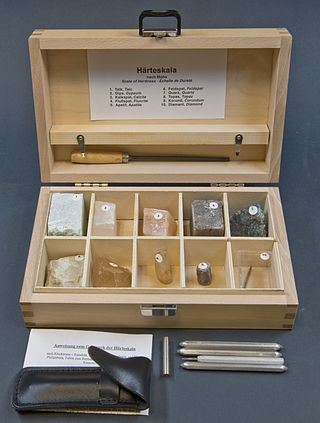
The Mohs scale of mineral hardness is a qualitative ordinal scale, from 1 to 10, characterizing scratch resistance of minerals through the ability of harder material to scratch softer material.
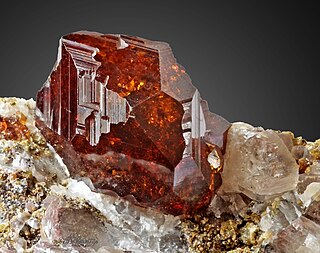
Garnets are a group of silicate minerals that have been used since the Bronze Age as gemstones and abrasives.

Henry Highland Garnet was an American abolitionist, minister, educator, orator, and diplomat. Having escaped as a child from slavery in Maryland with his family, he grew up in New York City. He was educated at the African Free School and other institutions, and became an advocate of militant abolitionism. He became a minister and based his drive for abolitionism in religion.
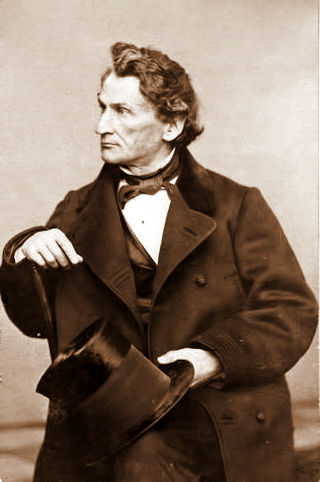
James Dwight DanaFRS FRSE was an American geologist, mineralogist, volcanologist, and zoologist. He made pioneering studies of mountain-building, volcanic activity, and the origin and structure of continents and oceans around the world.

Amateur geology or rock collecting is the non-professional study and hobby of collecting rocks and minerals or fossil specimens from the natural environment. In Australia, New Zealand and Cornwall, the amateur geologists call this activity fossicking. The first amateur geologists were prospectors looking for valuable minerals and gemstones for commercial purposes. Eventually, however, more people have been drawn to amateur geology for recreational purposes, mainly for the beauty that rocks and minerals provide.

Uvarovite is a chromium-bearing garnet group species with the formula: Ca3Cr2(SiO4)3. It was discovered in 1832 by Germain Henri Hess who named it after Count Sergei Uvarov (1765–1855), a Russian statesman and amateur mineral collector. It is classified in the ugrandite group alongside the other calcium-bearing garnets andradite and grossular.

Mindat.org is a non-commercial interactive online database covering minerals around the world. Originally created by Jolyon Ralph as a private project in 1993, it was launched as a community-editable website in October 2000. As of 2023 it is operated by the Hudson Institute of Mineralogy.
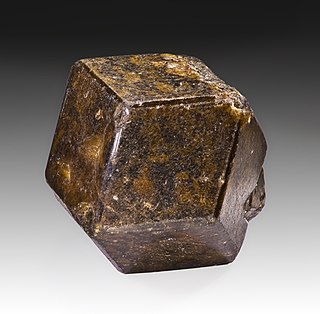
Andradite is a mineral species of the garnet group. It is a nesosilicate, with formula Ca3Fe2Si3O12.
Founded in 1958, the International Mineralogical Association (IMA) is an international group of 40 national societies. The goal is to promote the science of mineralogy and to standardize the nomenclature of the 5000 plus known mineral species. The IMA is affiliated with the International Union of Geological Sciences (IUGS).

George Frederick Kunz was an American mineralogist and mineral collector.

The endmember hornblende tschermakite (☐Ca2(Mg3Al2)(Si6Al2)O22(OH)2) is a calcium rich monoclinic amphibole mineral. It is frequently synthesized along with its ternary solid solution series members tremolite and cummingtonite so that the thermodynamic properties of its assemblage can be applied to solving other solid solution series from a variety of amphibole minerals.
The Delaware Mineralogical Society, Inc., also known as DMS, is a U.S. registered tax-deductible 503(c)(3) non-profit organization located in Wilmington, Delaware, US. Its primary purpose is to promote education in the earth sciences. DMS was instrumental in the recommendation of Delaware's official mineral Sillimanite to the Delaware State Legislature in 1977.
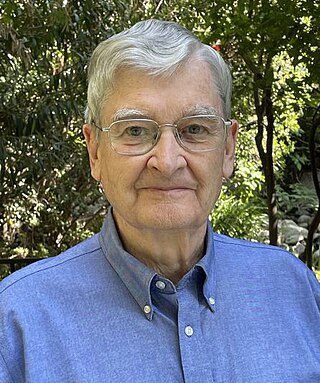
George R. Rossman is an American mineralogist and the Professor of Mineralogy at the California Institute of Technology.

Bernard Elgey Leake is an English geologist. He is Emeritus Professor of Geology at the University of Glasgow, was Leverhulme Emeritus Fellow at Cardiff University 2000-2002 and has been an Honorary Research Fellow at Cardiff University since 1997.
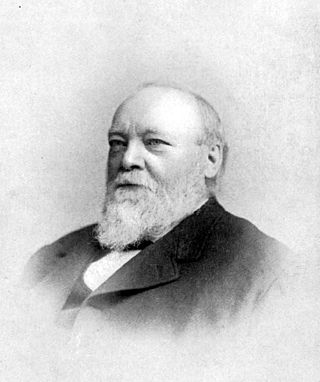
Frederick Augustus Ludwig Karl Wilhelm Genth was a German-American chemist, specializing in analytical chemistry and mineralogy.
John Sinkankas was a Navy officer and aviator, gemologist, gem carver and gem faceter, author of many books and articles on minerals and gemstones, and a bookseller and bibliographer of rare books.
Georgius Agricola is considered the 'father of mineralogy'. Nicolas Steno founded the stratigraphy, the geology characterizes the rocks in each layer and the mineralogy characterizes the minerals in each rock. The chemical elements were discovered in identified minerals and with the help of the identified elements the mineral crystal structure could be described. One milestone was the discovery of the geometrical law of crystallization by René Just Haüy, a further development of the work by Nicolas Steno and Jean-Baptiste L. Romé de l'Isle. Important contributions came from some Saxon "Bergraths"/ Freiberg Mining Academy: Johann F. Henckel, Abraham Gottlob Werner and his students. Other milestones were the notion that metals are elements too and the periodic table of the elements by Dmitri Ivanovich Mendeleev. The overview of the organic bonds by Kekulé was necessary to understand the silicates, first refinements described by Bragg and Machatschki; and it was only possibly to understand a crystal structure with Dalton's atomic theory, the notion of atomic orbital and Goldschmidt's explanations. Specific gravity, streak and X-ray powder diffraction are quite specific for a Nickel-Strunz identifier. Nowadays, non-destructive electron microprobe analysis is used to get the empirical formula of a mineral. Finally, the International Zeolite Association (IZA) took care of the zeolite frameworks.
Edward Manin Stolper is an American geologist, petrologist, and planetologist. He is known for his research on igneous rocks and volatiles in igneous processes, especially his research involving "pioneering experiments defining the behavior of volatiles in silicate melts and glasses."













